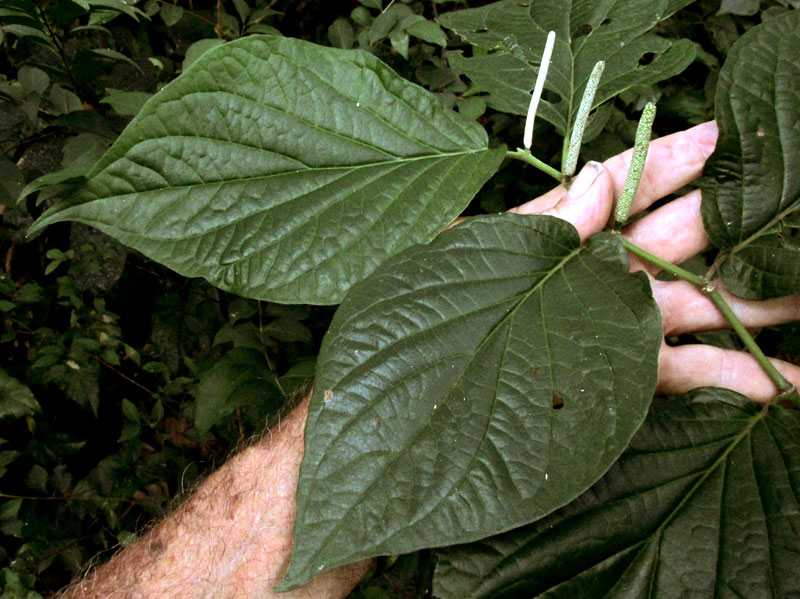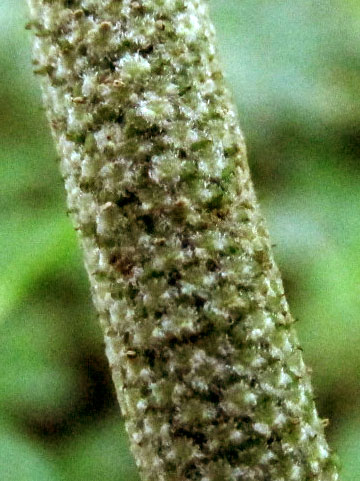Excerpts from Jim Conrad's
Naturalist Newsletter
entry from field notes dated October 6, 2022, taken along the main road on the northern side of Gómez Farías, on the lower eastern slope of the Eastern Sierra Madres, El Cielo Biosphere Reserve, southern Tamaulipas state, MÉXICO; elevation about 350m (1150 ft), ± LAT. 23.04°N, LONG. -99.15°W
PIPER cf. SCHIEDEANUM

Beside the road heading north out of the village of Gómez Farías, about 1km from the town park, the above bush or small tree grew at the very edge of a somewhat disturbed, steeply sloped, wooded area. With such distinctive spike-type flowering heads, each consisting of very many closely packed, much simplified flowers with no corollas or calyxes, the bush was clearly a member of the Black Pepper genus Piper, in the Black Pepper Family, the Piperaceae.
In 2022 Kew Garden's authoritative Plants of the World Online website recognizes about 2400 Piper species, so it's a big genus, nearly entirely tropical. The most famous Piper is Piper nigrum, native of southwestern India, but now planted widely in the tropics. From it comes black pepper, which is the world's most traded of all spices. Black pepper is prepared by grinding dried, 5mm-wide (0.2 inch) fruits, or peppercorns of Piper nigrum. Those fruits are much larger than the vast majority of other Piper species.
Since Piper species are overwhelmingly tropical, here in southern Tamaulipas state we're at the northernmost limit in Mexico where Piper species might occur. The 1995 publication of Alfonso Valiente-Banuet and others entitled La vegetación selvática de la región de Gómez Farías -- forest flora of the Gómez Farías region -- lists only one Piper species, the widely distributed Piper amalago, which our species isn't. Here's a close look at our species' crammed-together flowers:

In that picture, mostly what's seen is white, roundish bracts with finely hairy, or ciliate, margins, each bract arising below a single much-reduced flower. The bracts are attached to the rachis at their centers, umbrella-like. In the above picture, here and there, emerging from below a bract, you can see grainy-looking, pollen producing anthers, and slender stigmas atop hidden ovaries. The ovaries will mature into peppercorns. These are very typical Piper features, not helping much with identification.
Much more than in most families of flowering plants, species in the genus Piper often are easier distinguished by their vegetative features than by their flowers and fruits. The picture atop this page shows important features of our bush's leaves -- especially the size, shape, disposition of veins, the leaf surface being somewhat wrinkled, or rugose, and the leaf bases narrowing asymmetrically to short, backward-projecting, rounded lobes. The follow image shows other important vegetative features.

Leaf petioles of many Piper species are deeply grooved and at the point of attachment with the stem their bases wrap around the stem. This species' petioles don't do that. At the base of the white flowering spike at the right in the above picture, a slenderly triangular, sharp-tipped, green item arises. That's a prophyll, which is a specialized or reduced leaf sometimes produced at stem nodes. Prophyll size and shape vary among the species, so prophylls are good field marks. Also, note that this species' stems and petioles are covered with short, soft hairs -- they're puberulent -- while the leaf surface appears hairless.
Probably the best current treatment of the genus Piper for this general part of Mexico is the 2020 treatment of the Piperaceae Family in the Flora del Bajío y de regiones adyacentes, dealing with the Bajío Region of upland central Mexico. It documents 13 Piper species for the region, and provides an identification key to the species, which leads me to the species PIPER SCHIEDEANUM.
However, no literature I can find lists Piper schiedeanum as occurring in Tamaulipas state, though it does appear in the nearby state of San Luis Potosí. Some current literature has the species restricted just to Mexico while other sources have it extending into Central and South America. Mexican herbarium specimens of the species show leaves with bases not as narrow and asymmetrical as our bush's leaves, while images at the Plants of the World Online website show leaves more like ours, but on stems bearing flowering spikes and prophylls considerably longer than ours. The Flora del Bajío does say that leaves of Piper schiedeanum are very variable in size and form, even on the same plant.
The best I can do is to file this page under the keywords "Piper cf. schiedeanum," the "cf." meaning "confirm," because I'm not really sure what we have here. Someday a specialist may come along and be happy with our documentation, and make some sense of it.